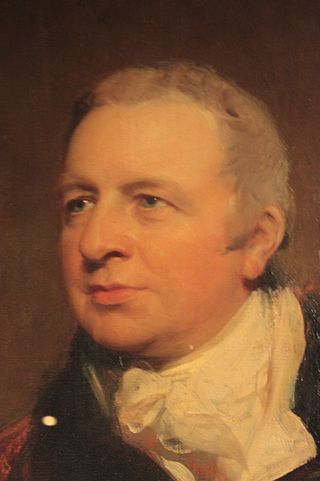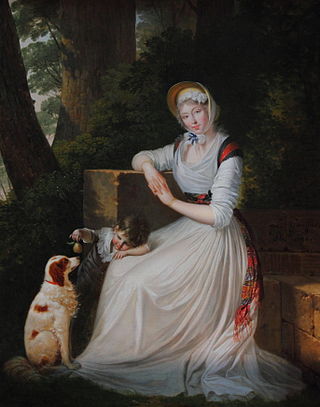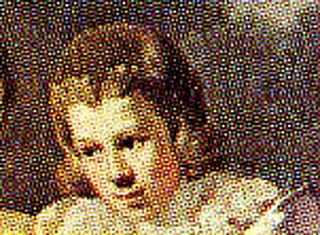
Sir George Nugent, 1st Baronet, GCB was a British Army officer. After serving as a junior officer in the American Revolutionary War, he fought with the Coldstream Guards under the Duke of York during the Flanders Campaign. He then commanded the Buckinghamshire Volunteers in the actions of St. Andria and Thuyl on the river Waal and participated in the disastrous retreat from the Rhine. He went on to be commander of the northern district of Ireland, in which post he played an important part in placating the people of Belfast during the Irish Rebellion, and then became Adjutant-General in Ireland. He went on to be Governor of Jamaica, commander of the Western District in England, commander of the Kent District in England and finally Commander-in-Chief, India.

Trengwainton is a garden situated in Madron, near Penzance, Cornwall, England, UK, which has been in the ownership of the National Trust since 1961. The garden is noted for its collection of exotic trees and shrubs and offers views over Mount's Bay and The Lizard. The house is not open to the public.

George Hibbert was an English merchant, politician, slave-owner, ship-owner, amateur botanist and book collector. With Robert Milligan, he was also one of the principals of the West India Dock Company which instigated the construction of the West India Docks on London's Isle of Dogs in 1800. He also helped found the Royal National Lifeboat Institution in 1824.
Sir John Dashwood-King, 4th Baronet was a British Tory politician and country gentleman.
There have been six baronetcies created for persons with the surname Price, one each in the baronetages of England and of Great Britain and four in the baronetage of the United Kingdom. Two of the creations were extant as of 2008.

St Maddern's Church is the parish church of Madron, near Penzance in Cornwall and was once the mother church of Morvah and Penzance. It is a Grade I listed building.

Elizabeth Vassall Fox, Baroness Holland was an English political hostess and the wife of Whig politician Henry Vassall-Fox, 3rd Baron Holland. With her husband, and after his death, she hosted political and literary gatherings at their home, Holland House.
Sir John Rae Reid, 2nd Baronet (1791–1867) was a British merchant and financier. He was a Tory and Conservative politician who sat in the House of Commons between 1830 and 1847.

Sir William Young, 2nd Baronet, FRS, FSA was a British colonial governor, politician and owner of sugar plantations which, in 1788, included 896 enslaved Africans. He was the governor of Tobago from 1807 – January 1815, and Member of Parliament for St Mawes, 19 June 1784 – 3 November 1806, and Buckingham, 5 November 1806 – 23 March 1807.

The Rum Story is a visitor attraction and museum in Whitehaven, Cumbria, England. It presents the story of the rum trade and the creation of rum. It is located in an original 1785 trading shop and warehouses.
The Champneys, later Mostyn-Champneys Baronetcy, of Orchardleigh in the County of Somerset, was a title in the Baronetage of Great Britain. It was created on 12 January 1767 for Thomas Champneys, subsequently High Sheriff of Somerset from 1775 to 1776. He owned the Orchardleigh estate near Frome and other English properties. In 1771 he inherited from his uncle, Anthony Sywmmer a sizeable plantation: Nutt's River, in the parish of St Thomas in the East, Surrey, close to Morant Bay, Jamaica. This estate produced sugar, rum and livestock, mainly cattle. In 1810, 241 slaves were counted as part of the property. By 1817 it had grown to a total of 260, 134 males and 126 females, including children. Leaving his wife and children in England, he spent several years (1784–90) in Jamaica, joining the local Trelawney Militia as an artillery superintendent and overseeing the Windward coastal fort, in addition to being a magistrate in the parish of St Thomas in the East and St David, Surrey. His financial affairs deteriorated; his father-in-law, Richard Cox stepped in and by the turn of the 19th century had mortgaged all his properties, his remaining manors of Orchardleigh and Frome Selwood, along with Nutt's River, foreclosing on the eventual bankruptcy. He died in Orchardleigh in 1821.
Sir Edward Hoblyn Warren Bolitho was a Cornish landowner and politician. He was Chairman of Cornwall County Council from 1941 to 1952 and Lord Lieutenant of Cornwall from 1936 to 1962, for some years serving in both roles simultaneously.
James Laing (c.1749–1831) was a Scottish doctor and slave plantation owner in Dominica.
William Pulsford (1772–1833), the elder, was a London merchant and a plantation owner in Jamaica. He became a landowner in several English counties.
Thomas Robins Bolitho (1840–1925) was an English banker and landowner, who served as High Sheriff of Cornwall in 1890.
Fulke Rose was a British physician and early colonist of Jamaica. He was one of the principal buyers in Jamaica of slaves taken by the Royal African Company and had extensive land-holdings on the island. He continued to practice medicine in Jamaica and with Hans Sloane attended the former privateer Henry Morgan towards the end of Morgan's life.
Francis Rose was a plantation owner in Jamaica. He was active in the politics of the island and was elected to serve in the House of Assembly of Jamaica multiple times, becoming speaker in 1702, and later president of the Council of Jamaica.
Marianne Thornton was an English human rights activist, who campaigned for the abolition of slavery.

Emma Colebrooke or Emma, Lady Tankerville was a British heiress, art patron and botanist. Lady Tankerville's collection of botanical illustrations are held at the Royal Botanic Gardens, Kew. Phaius tankerville was named in her honour by Sir Joseph Banks because it was the first tropical orchid to flower in England and it flowered in her greenhouse.

Turvey House and Gardens are a country house, gardens and parkland, situated by the village of Turvey in Bedfordshire, England. The gardens and parkland are listed Grade II in Historic England's Register of Parks and Gardens. and the house is a Grade I listed building. The house is a venue for weddings, events and location shoots.









